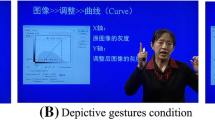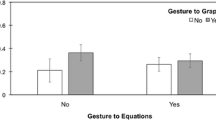Abstract
Previous studies have shown that teachers’ gestures are beneficial for student learning. In this research, we investigate whether teachers’ gestures have comparable effects in face-to-face live instruction and video-based instruction. We provided sixty-three 7–10 year old students with instruction about mathematical equivalence problems (e.g., 3 + 4 + 5 = __ + 5). Students were assigned to one of four experimental conditions in a 2 × 2 factorial design that varied (1) instruction medium (video vs. live), and (2) instruction modality (speech vs. speech + gesture). There was no main effect of medium: The same amount of learning occurred whether instruction was done live or on video. There was a main effect of modality: Speech instruction accompanied by gesture resulted in significantly more learning and transfer than instruction conveyed through speech only. Gesture’s effect on instruction was stronger for video instruction than live instruction. These findings suggest that there may be a limit to gesture’s role in communication that results in student learning.

Similar content being viewed by others
Notes
The gender and ethnic distribution of the included children did not differ from the excluded children (i.e., excluded for all reasons stated in the text). The proportion of females for those included versus excluded participants was 53 % and 47 % respectively, χ²(1, N = 68) = .10, p = .75. The proportion of Caucasians for those included and excluded participants was 53 % and 54 % respectively, χ²(1, N = 76) = .01, p = .92.
The pretest and posttest can be provided upon request.
Children were randomly assigned to experimental conditions. However, there was variation in the number of children excluded from each experimental condition. All children completed the pretest portion of the protocol. If a child failed to solve the basic problems correctly or correctly solved some or all of the pretest problems, they were then let go from continuing the protocol. This may have led to uneven N’s in the experimental conditions.
References
Alibali, M. W., & Goldin-Meadow, S. (1993). Gesture-speech mismatch and mechanisms of learning: What the hands reveal about a child’s state of mind. Cognitive Psychology, 25, 468–523.
Alibali, M. W., Nathan, M. J., Church, R. B., Wolfgram, M. S., Kim, S., & Knuth, E. J. (2013). Teachers’ gesture and speech in mathematics lessons: Forging common ground by resolving trouble spots. ZDM—International Journal on Mathematics Education, 45, 425–440. doi:10.1007/s11858-012-0476-0.
Alibali, M. W., Nathan, M. J., & Fujimori, Y. (2011). Gestures in the mathematics classroom: What’s the point? In N. L. Stein & S. W. Raudenbush (Eds.), Developmental cognitive science goes to school (pp. 219–234). New York: Routledge, Taylor & Francis.
Allen, I. E., & Seaman, J. (2006). Making the grade: Online education in the United States. Needham, MA: The Sloan Consortium.
Allen, I. E., & Seaman, J. (2009). Learning on demand: Online education in the United States, 2009. Newburyport, MA: The Sloan Consortium.
Bates, D., Maechler, M., Bolker, B. M., & Walker, S. C. (2014). Fitting linear mixed-effects models using lme4. Journal of Statistical Software, 67(1), 1–48. doi:10.18637/jss.v067.i01.
Ben-Zeev, T., & Star, J. R. (2001). Spurious correlations in mathematical thinking. Cognition and Instruction, 19, 253–275.
Broaders, S., Cook, S. W., Mitchell, Z., & Goldin-Meadow, S. (2007). Making children gesture reveals implicit knowledge and leads to learning. Journal of Experimental Psychology: General, 136(4), 539–550.
Brophy, J. (2004). Using video in teacher education. San Diego, CA: Elsevier.
Church, R. B., Ayman-Nolley, S., & Mahootian, S. (2004). The role of gesture in bilingual education: Does gesture enhance learning? International Journal of Bilingual Education and Bilingualism, 7, 303–319.
Church, R. B., Garber, P., & Rogalski, K. (2007). The role of gesture in memory and social communication. Gesture, 7, 137–158.
Cook, S. W., Duffy, R. G., & Fenn, K. M. (2013). Consolidation and transfer of learning after observing hand gesture. Child Development, 84, 1863–1871. doi:10.1111/cdev.12097.
Cook, S. M., & Goldin-Meadow, S. (2006). The role of gesture in learning: Do children use their hands to change their minds? Journal of Cognition and Development, 7, 211–232.
Cook, S. W., Mitchell, Z., & Goldin-Meadow, S. (2008). Gesturing makes learning last. Cognition, 106(2), 1047–1058.
Craig, S. D., Chi, M. T. H., & Van Lehn, K. (2009). Improving classroom learning by collaboratively observing human tutoring videos while problem solving. Journal of Educational Psychology, 101, 779–789.
Crowder, E. M., & Newman, D. (1993). Telling what they know: The role of gesture and language in children’s science explanations. Pragmatics & Cognition, 1, 341–376.
Euzent, P., Martin, T., Moskal, P., & Moskal, P. (2011). Assessing student performance and perception in lecture capture versus face-to-face course delivery. Journal of Information Technology Education, 10, 295–307.
Flevares, L. M., & Perry, M. (2001). How many do you see? The use of nonspoken representations in first-grade mathematics lessons. Journal of Educational Psychology, 93, 330–345.
Goldin-Meadow, S., Kim, S., & Singer, M. (1999). What the teacher’s hands tell the student’s mind about math. Journal of Educational Psychology, 91, 720–730.
Goldin-Meadow, S., & Singer, M. A. (2003). From children’s hands to adults’ ears: Gesture’s role in the learning process. Developmental Psychology, 39, 509–520.
Gullberg, M., & Holmqvist, K. (2006). What speakers do and what addressees look at: Visual attention to gestures in human interaction live and on video. Pragmatics & Cognition, 14, 53–82.
Hayne, H., Herbert, J., & Simcock, G. (2003). Imitation from television by 24- and 30-month-olds. Developmental Science, 6(3), 254–261.
Hostetter, A. B. (2011). When do gestures communicate? A meta-analysis. Psychological Bulletin, 137(2), 297–315.
Hostetter, A. B., & Alibali, M. W. (2008). Visible embodiment: Gestures as simulated action. Psychonomic Bulletin & Review, 15(3), 495–514.
Marghetis, T., & Nunez, R. (2013). The motion behind the symbols: A vital role for dynamism in the conceptualization of limits and continuity in expert mathematics. Topics in Cognitive Science, 5, 299–316.
McNeill, D. (1992). Hand and mind: What gestures reveal about thought. Chicago, IL: University of Chicago Press.
McNeill, D. (2005). Iconic gestures of children and adults. Semiotica, 62(1–2), 107–128. doi:10.1515/semi.1986.62.1-2.107.
Perry, M., Church, R. B., & Goldin-Meadow, S. (1988). Transitional knowledge in the acquisition of concepts. Cognitive Development, 3(4), 359–400.
Pine, K. J., Lufkin, N., & Messer, D. (2004). More gestures than answers: Children learning about balance. Developmental Psychology, 40(6), 1059–1067. doi:10.1037/0012-1649.40.6.1059.
Singer, M. A., & Goldin-Meadow, S. (2005). Children learn when their teacher’s gestures and speech differ. Psychological Science, 16, 85–89.
Singer, M., Radinsky, J., & Goldman, S. R. (2008). The role of gesture in meaning construction. Discourse Processes, 45, 365–386.
Valenzeno, L., Alibali, M. A., & Klatzky, R. (2003). Teachers’ gestures facilitate students’ learning: A lesson in symmetry. Contemporary Educational Psychology, 28, 187–204.
Wagner, S. M., Lourenco, S.F., Ellois, V., & Parisi, D. (2003). Hands on learning: How do children attend to teachers’ gestures? Poster session at the annual meeting of the Society for Research in Child Development, Tampa, Florida.
Wang, X., Bernas, R., & Eberhard, P. (2004). Engaging ADHD students in tasks with hand gestures: A pedagogical possibility for teachers. Educational Studies, 30, 217–229.
Zang, D., Zhou, L., Briggs, R. O., & Nunemaker, J. F. (2006). Instructional video in e-learning: Assessing the impact of interactive video on learning effectiveness. Information & Management, 43, 15–27.
Acknowledgments
We would like to thank all the schools who participated in this study. We would also like to thank Vanda Chitrapongse and Hanan Abdelwahab for their help with the preparation of this study.
Author information
Authors and Affiliations
Corresponding author
Rights and permissions
About this article
Cite this article
Koumoutsakis, T., Church, R.B., Alibali, M.W. et al. Gesture in Instruction: Evidence from Live and Video Lessons. J Nonverbal Behav 40, 301–315 (2016). https://doi.org/10.1007/s10919-016-0234-z
Published:
Issue Date:
DOI: https://doi.org/10.1007/s10919-016-0234-z




